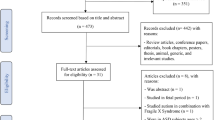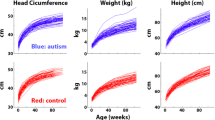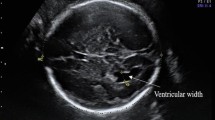Abstract
Siblings of children with autism have an increased risk for autism spectrum disorders (ASD). As children with autism often exhibit an atypical trajectory of head circumference (HC) growth, HC may be an indicator of vulnerability to autism. This study investigated whether infant siblings of children with ASD (n = 77) with an atypical trajectory of HC growth were more likely than those without an atypical HC trajectory to develop autism symptoms. Results showed that infants who had larger HC at 12 months, and whose HC growth rate decelerated more rapidly between 12 and 24 months were more likely to exhibit autism symptoms than infants with more typical HC trajectories. Among infant siblings of children with autism, atypical HC growth might alert pediatricians to provide screening and/or referral for further evaluation.




Similar content being viewed by others
References
American Psychiatric Association. (2000). Diagnostic and statistical manual of mental disorders, fourth edition, text revision. Washington, DC: American Psychiatric Association.
August, G. J., Stewart, M. A., & Tsai, L. (1981). The incidence of cognitive disabilities in the siblings of autistic children. British Journal of Psychiatry, 138, 416–422.
Bailey, A., Phillips, W., & Rutter, M. (1996). Autism: Towards an integration of clinical, genetic, neuropsychological and neurobiological perspectives. Journal of Child Psychology & Psychiatry, 37, 89–126.
Baird, T. D., & August, G. J. (1985). Familial heterogeneity in infantile autism. Journal of Autism and Developmental Disorders, 15, 315–322.
Baranek, G. T. (1999). Autism during infancy: A retrospective video analysis of sensory-motor and social behaviors at 9–12 months of age. Journal of Autism and Developmental Disorders, 29, 213–224.
Barthlomeusz, H. H., Courchesne, E., & Karns, C. M. (2002). Relationship between head circumference and brain volume in healthy normal toddlers, children, and adults. Neuropediatrics, 33, 239–241.
Bristol-Power, M. M., & Spinella, G. (1999). Research on screening and diagnosis in autism: A work in progress. Journal of Autism and Developmental Disorders, 29, 435–438.
Byrk, A. S., & Raudenbush, S. W. (2002). Hierarchical linear models: Applications and data analysis methods. Thousand Oaks: Sage.
Cassel, T. D., Messinger, D. S., Ibanez, L. V., Haltigan, J. D., Acosta, S. I., & Buchman, A. C. (2007). Early social and emotional communication in the infant siblings of child with autism spectrum disorders: An examination of the broad phenotype. Journal of Autism and Developmental Disorders, 37, 122–132.
Chawarska, K., Paul, R., Klin, A., Hannigen, S., Dichtel, L. E., & Volkmar, F. (2007). Parental recognition of developmental problems in toddlers with autism spectrum disorders. Journal of Autism and Developmental Disorders, 37, 62–72.
Courchesne, E., Carper, R., & Akshoomoff, N. (2003). Evidence of brain overgrowth in the first year of life in autism. Journal of the American Medical Association, 290, 337–344.
Courchesne, E., Karns, C. M., Davis, H. R., Ziccardi, R., Carper, R. A., Tigue, Z. D., Chisum, H. J., Moses, P., Pierce, K., Lord, C., Lincoln, A. J., Pizzo, S., Schreibman, L., Haas, R. H., Akshoomoff, N. A., & Couchesne, R. Y. (2001). Unusual brain growth patterns in early life in patients with autistic disorder an MRI study. Neurology, 57, 245–254.
Courchesne, E., & Pierce, K. (2005). Brain overgrowth in autism during a critical time in development: Implications for frontal pyramidal neuron and interneuron development and connectivity. International Journal of Developmental Neuroscience, 23, 153–170.
Cox, A., Charman, T., Baron-Cohen, S., Drew, A., Klein, K., Baird, G., Swettenham, J., & Wheelwright, S. (1999). Autism spectrum disorders and 20 and 42 months of age: Stability of clinical and ADI-R diagnosis. Journal of Child Psychology and Psychiatry, 40, 719–732.
Dawson, G., Munson, J., Webb, S. J., Nalty, T., Abbott, R., & Toth, K. (2007). Rate of head growth decelerates and symptoms worsen in the second year of life in autism. Biological Psychiatry, 15, 458–464.
De Giacomo, A., & Fombonne, E. (1998). Parental recognition of developmental abnormalities in autism. European Child & Adolescent Psychiatry, 7, 131–136.
Deutsch, C. K., & Joseph, R. M. (2003). Brief report: Cognitive correlates of enlarged head circumference in children with autism. Journal of Autism and Developmental Disorders, 33, 209–215.
Fidler, D. J., Bailey, J. N., & Smalley, S. L. (2000). Macroencephaly in autism and other pervasive developmental disorders. Developmental Medicine & Child Neurology, 42, 737–740.
Fombonne, E. (2005). The changing epidemiology of autism. Journal of Applied Research in Intellectual Disabilities, 18, 281–294.
Gamliel, I., Yirmiya, N., & Sigman, M. (2007). The development of young siblings of children with autism from 4 to 54 months. Journal of Autism and Developmental Disorders, 37, 171–183.
Gillberg, C., & de Souza, L. (2002). Head circumference in autism, Asperger syndrome, and ADHD: A comparative study. Developmental Medicine and Child Neurology, 44, 296–300.
Harris, S. L., & Handleman, J. S. (2000). Age and IQ at intake as predictors of placement for young children with autism: A four- to six-year follow-up. Journal of Autism and Developmental Disorders, 21, 281–290.
Kanner, L. (1943). Autistic disturbances of affective contact. Nervous Child, 2, 217–250.
Lord, C. (1995). Follow-up of two year-olds referred for possible autism. Journal of Child Psychology and Psychiatry, 36, 1365–1382.
Lord, C., Risi, S., DiLavore, P. S., Shulman, C., Thurm, A., & Pickles, A. (2006). Autism from 2 to 9 years of age. Archives of General Psychiatry, 63, 694–701.
Lord, C., Schopler, E., & Revicki, D. (1982). Sex differences in autism. Journal of Autism and Developmental Disorders, 12, 317–330.
Maestro, S., Muratori, F., Barbieri, F., Casella, C., Cattaneo, V., Cavallaro, M. C., Cesari, A., Milone, A., Rizzo, L., Viglione, V., Stern, D. D., & Palacio-Espasa, F. (2001). Early behavioral development in autistic children: The first 2 years of life through home movies. Psychopathology, 34, 147–152.
Maestro, S., Muratori, F., Cavallaro, M. C., Pei, F., Stern, D., Golse, B., et al. (2002). Attentional skills during the first 6 months of age in autism spectrum disorder. Journal of the American Academy of Child and Adolescent Psychiatry, 41, 1239–1245.
Mars, A. E., Mauk, J. E., & Dowrick, P. W. (1998). Symptoms of pervasive developmental disorders as observed in prediagnostic home videos of infants and toddlers. Journal of Pediatrics, 132, 500–504.
McEachin, J. J., Smith, T., & Lovaas, O. I. (1993). Long-term outcome for children with autism who received early intensive behavioral treatment. American Journal on Mental Retardation, 97, 359–372.
McGee, G. G., Morrier, M., & Daly, T. (1999). An incidental teaching approach to early intervention for toddlers with autism. Journal of the Association for Persons with Severe Handicaps, 24, 133–146.
Mitchell, S., Brian, J., Zwaigenbaum, L., Roberts, W., Szatmari, P., Smith, I., & Bryson, S. (2006). Early language and communication development of infants later diagnosed with autism spectrum disorder. Developmental and Behavioral Pediatrics, 27, S69–S78.
Mouridsen, S. E., Rich, B., & Isager, T. (2000). A comparative study of genetic and neurobiological findings in disintegrative psychosis and infantile autism. Psychiatry and Clinical Neurosciences, 54, 441–446.
Mraz, K. D., Green, J., Dumont-Mathieu, T., Makin, S., & Fein, D. (2007). Correlates of head circumference growth in infants later diagnosed with autism spectrum disorders. Journal of Child Neurology, 22, 700–713.
National Center for Health Statistics Center for Disease Control. (2002). Clinical growth charts. National Health and Nutrition Examination Survey [On-line]. Available: http://www.cdc.gov/nchs/about/major/nhanes/growtOFCharts/clinical_charts.htm.
Osterling, J., & Dawson, G. (1994). Early recognition of children with autism: A study of first birthday home video tapes. Journal of Autism and Developmental Disorders, 24, 247–257.
Osterling, J. A., Dawson, G., & Munson, J. A. (2002). Early recognition of 1-year-old infants with autism spectrum disorder versus mental retardation. Development and Psychopathology, 14, 239–251.
Piven, J., Gayle, J., Chase, G. A., Fink, B., Landa, R., Wzorek, M. M., et al. (1990). A family history study of neuropsychiatric disorders in the adult siblings of autistic individuals. Journal of the American Academy of Child and Adolescent Psychiatry, 29, 177–183.
Redcay, E., & Courchesne, E. (2005). When is the brain enlarged in autism? A meta-analysis of all brain size reports. Biological Psychiatry, 58, 1–9.
Robins, D. L., Fein, D., Barton, M. L., & Green, J. A. (2001). The modified checklist for autism in toddlers: An initial study investigating the early detection of autism and pervasive developmental disorders. Journal of Autism and Developmental Disorders, 31, 131–144.
Rogers, S. J. (1998). Empirically supported comprehensive treatments for young children with autism. Journal of Clinical Child Psychology, 27, 168–179.
Scott, F. J., Baron-Cohen, S., Bolton, P., & Brayne, C. (2002). Brief report: Prevalence of autism spectrum conditions in children aged 5–11 years in Cambridgeshire, UK. Autism, 6, 231–237.
Smalley, S. L., Asarnow, R. F., & Spence, A. (1988). Autism and genetics. Archives of General Psychiatry, 30, 405–416.
Smith, T., Groen, A. D., & Wynn, J. W. (2000). Randomized trial of intensive early intervention for children with pervasive developmental disorder. American Journal on Mental Retardation, 105, 269–285.
Sparks, B. G., Friedman, S. D., Shaw, D. W., Aylward, E. H., Echelard, D., Artru, A. A., et al. (2002). Brain structural abnormalities in young children with autism spectrum disorder. Neurology, 59, 184–192.
Toth, K., Dawson, G., Meltzoff, A. N., Greenson, J., & Fein, D. (2007). Early social, imitation, play, and language abilities of young non-autistic siblings of children with autism. Journal of Autism and Developmental Disorders, 37, 145–157.
Veenstra-Vanderweele, J., & Cook, E. H. Jr. (2003). Genetics of childhood disorders: XLVI. Autism, part 5: Genetics of autism. Development and Neurobiology, 42, 116–118.
Volkar, F. R., Szatmari, P., & Sparrow, S. S. (1993). Sex differences in pervasive developmental disorders. Journal of Autism and Developmental Disorders, 4, 579–591.
Werner, E., & Dawson, G. (2005). Validation of the phenomenon of autistic regression using home videotapes. Archives of General Psychiatry, 62, 889–895.
Werner, E., Dawson, G., Munson, J., & Osterling, J. (2005). Variation in early developmental course in autism and its relation with behavioral outcome at 3–4 years of age. Journal of Autism & Developmental Disorders, 35, 337–350.
Wiggins, L. D., Baio, J., & Rice, C. (2006). Examination of the time between first evaluation and first autism spectrum diagnosis in a population-based sample. Journal of Developmental & Behavioral Pediatrics, 27, S79–S87.
Wing, L. (1981). Sex ratios in early childhood autism and related conditions. Psychiatric Research, 5, 129–137.
Woods, J. J., & Wetherby, A. M. (2003). Early identification of and intervention for infants and toddlers who are at risk for autism spectrum disorder. Language, Speech, and Hearing Services and Schools, 34, 180–193.
Acknowledgments
We wish to thank the children and parents who participated in this study. This research was funded by grants from the National Institute of Child Health and Human Development (U19HD34565, P50HD066782, and R01HD-55741) and the National Institute of Mental Health (U54MH066399; R01HD039961).
Author information
Authors and Affiliations
Corresponding author
Rights and permissions
About this article
Cite this article
Elder, L.M., Dawson, G., Toth, K. et al. Head Circumference as an Early Predictor of Autism Symptoms in Younger Siblings of Children with Autism Spectrum Disorder. J Autism Dev Disord 38, 1104–1111 (2008). https://doi.org/10.1007/s10803-007-0495-9
Received:
Accepted:
Published:
Issue Date:
DOI: https://doi.org/10.1007/s10803-007-0495-9




